The Sun’s outermost layers, specifically the atmosphere, are responsible for producing all types of radiation that we detect. The photosphere, which is the deepest and densest layer of the atmosphere, is approximately 200-300 km thick and has a matter density of about 10-5 kg/m3. This density is significantly lower than that of the Earth’s atmosphere, which is equal to 1 kg/m3 at the Earth’s surface. Despite its relatively small thickness and density, the photosphere blocks all forms of radiation originating from the Sun’s deeper layers, preventing us from observing its sub-photospheric regions. The temperature of the photosphere increases as you move deeper into its layers and has an average temperature of 6000 K. This temperature is considered the surface temperature, and the photosphere itself is regarded as the Sun’s surface, marking the starting point of its atmospheric layers.
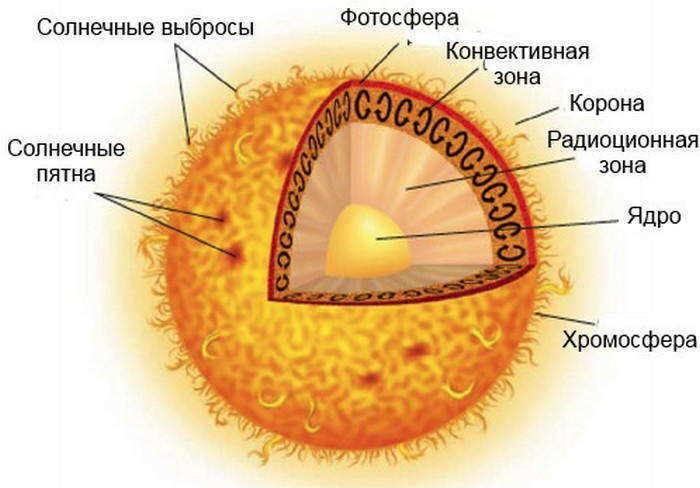
Composition of the Sun’s Atmosphere
Comprising of three layers, the Sun’s atmosphere lacks a distinct boundary between each. The closest layer to the photosphere, known as the transition layer, is both the densest and thinnest. Moving outward, the next layer, known as the chromosphere (derived from the Greek word “chromos” meaning “color”), is more extensive and less dense. The Sun’s chromosphere exhibits a reddish tint.
The chromosphere can be observed as a luminous ring surrounding the Moon during a total solar eclipse. This ring, which appears black, is actually the Moon blocking the Sun’s light. The chromosphere is made up of elongated tongues called spicules, giving it the appearance of burning grass. These spicules have a temperature two to three times hotter than the photosphere and are much less dense. The total length of the chromosphere is around 10-15 thousand kilometers.
The solar corona, on the other hand, is the third and most expansive layer of the Sun’s atmosphere. It is extremely sparse and can be seen as a radiant glow with a pearlescent hue.
The photosphere exhibits a distinctive pattern known as granulation, which is characterized by the presence of granules that resemble grains of rice. These granules have an angular size of 1-2′, but their linear dimensions can extend to thousands of kilometers. Observations have shown that the granulation is a dynamic process, with some granules disappearing and being replaced by new ones. On average, each granule has a lifespan of 5 to 10 minutes. The movement of the spectral lines in the spectrum of the brighter and hotter central part of the granule indicates the upward movement of hot material from beneath the photosphere. Conversely, the spectral lines in the spectrum of the darker and cooler matter surrounding the granule show a downward movement of material beneath the photosphere.
The speed at which gas rises and falls in the layers of the solar atmosphere is approximately 1 km/s, and there is a temperature difference of about 300 K between hot and cold matter. The pattern of granulation is similar to the pattern seen on the surface of boiling water, which is known as convection. In the case of boiling water, the hotter, lighter water rises to the top, releases its energy to the surrounding space, cools down, and then sinks back down. Detailed measurements have revealed that the surface of boiling water forms cells, with the hotter substance rising in each cell and the cooler substance sinking at the edges. Therefore, the granulation observed on the Sun indicates that energy is transferred from the deeper and hotter layers of the Sun to the photosphere through convection.
Solar Spots
Sunspots are dark regions that can be seen on the bright surface of the sun, known as the photosphere. These sunspots are intricate structures that consist of a central dark region, referred to as the shadow, and a surrounding lighter area. Within the lighter area, there are both dark and light formations that stretch out along the radius of the spot, which is called the penumbra.
The size of sunspots can vary greatly. When using small telescopes with approximately 50x magnification, sunspots with an angular cross section of 4-5″ can be observed. These spots appear as small black dots without any indication of penumbra, but in reality, they have linear dimensions of around 3000-3500 km. Sunspots with angular sizes of about 18″ have linear cross sections that are comparable to the diameter of Earth, which is approximately 13,000 km. Occasionally, the largest sunspots can have angular diameters as large as 4′, which is 0.13 times the diameter of the Sun, resulting in linear sizes approaching 180,000 km. These exceptionally large spots are even visible to the naked eye, although only when viewed through a dark light filter.

As a result, the temperature of sunspots is limited to the range of 3400 to 4000 K.
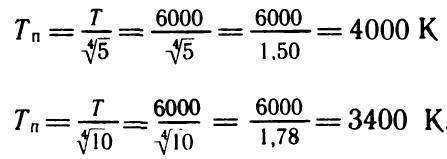
Photos of sunspots clearly display a pattern of dark and light areas in the penumbra of the sunspot, resembling the arrangement of iron filings in a magnetic field, with the elongated dark areas aligned along magnetic lines. The existence of a strong magnetic field in the sunspots is also confirmed by spectral observations. Some sunspots exhibit magnetic induction levels of 0.5 Tesla and above, whereas the average induction in the photosphere is 10^-4 – 10^-3 Tesla. In the center of a sunspot, the magnetic induction vector is perpendicular to the surface of the Sun, while at the edges, in the penumbra, it follows the surface and has a smaller value.
The low temperature of sunspots is attributed to the strong magnetic field surrounding them. This is because the photosphere, which is made up of charged particles, forms a plasma. The presence of a strong magnetic field hampers the movement of the plasma, slowing down its convection and reducing the flow of energy from the Sun’s inner layers. As a result, the temperature of the matter within the sunspot decreases, causing the spot to appear darker compared to the bright photosphere.
Sunspots typically appear in groups, with the largest sunspot positioned ahead in the direction of the Sun’s rotation. It has a magnetic field polarity that is opposite to that of the smaller sunspot that follows it. Additionally, the leading sunspot in the northern hemisphere of the Sun has a polarity opposite to that of the leading sunspot in the southern hemisphere.
In addition to the spots on the photosphere, flares – luminous formations with a relatively complex fibrous structure – are frequently observed near the periphery of the solar disk. Certain flares have a lifespan of several weeks. They possess a brightness that slightly surpasses that of the photosphere, and their temperature is only slightly higher, by 200-300 K.
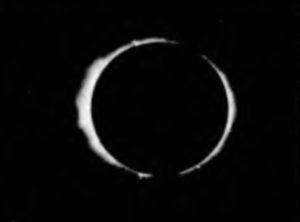
The image displays a photograph capturing the Sun during a complete solar eclipse that occurred on July 31, 1981. The exposure settings were carefully adjusted to reveal a thin layer of the chromosphere and the inner portion of the outer layer of the Sun’s atmosphere, known as the corona. The corona appears as a radiant pearly glow, significantly dimmer than the photosphere. By using longer exposure times, the corona can be observed extending up to ten or more times the diameter of the Sun. This particular image showcases the most luminous section of the solar corona, while also highlighting several prominent structures resembling bright emissions.
The temperature of the Sun’s atmosphere initially decreases from 6000 K in the photosphere to 4800 K in the lower levels of the chromosphere, then experiences a rapid increase in the upper layers and corona. The average temperature of the chromospheric material is approximately 20,000 K. The high temperature in the chromosphere is what causes the excitement of helium atoms and the resulting glow.
Research on the sun’s corona has revealed that it is composed of an extremely thin plasma with a temperature of around two million kelvins (2*10^6 K). The density of the corona is hundreds of billions of times lower than that of the air near the Earth’s surface. In such conditions, neutral atoms of chemical elements cannot exist because their velocity is so high that they lose electrons and become ionized through collisions. As a result, the primary constituents of the solar corona are protons, helium nuclei, and free electrons, with small amounts of other chemical elements. This is why the spectrum of the solar corona lacks hydrogen, helium, and sodium lines (which are characteristic of the chromosphere’s spectrum), and the faint, hardly noticeable continuous background of the spectrum is caused by the scattering of light from the photosphere by electrons.
The high temperature of the corona and the rarefaction of its matter are linked to the mystery surrounding the two distinct lines observed in its spectrum – green λ = 5303 Å and red λ = 6374 Å. When comparing the positions of these lines to the emission spectra of known chemical elements obtained in laboratories, no positive correlations were found. Astronomers previously encountered a similar situation that led to the discovery of helium. Consequently, scientists initially hypothesized the existence of a new chemical element, which they dubbed koronium. However, another theory emerged suggesting that these lines actually belong to a known chemical element. In the highly rarefied and hot corona, this element emits waves that correspond to the observed spectral lines.
By the early 1940s, a theoretical analysis of the ionization and excitation of atoms in the physical conditions of the solar corona revealed that these two enigmatic spectral lines can be attributed to iron atoms in a highly ionized state. The green line is emitted by an iron atom that has lost 13 of its outer electrons, while the red line corresponds to an iron atom that has lost 9 of its outer electrons. Subsequent research demonstrated that many of the emission lines observed in the corona are associated with elements in a highly ionized state.
Observation of coronal emission lines mainly occurs in the ultraviolet and X-ray regions of the spectrum. Special telescopes equipped with ultraviolet and X-ray detectors are installed on space research stations for this purpose. The Soviet solar observatory on board the Salyut space station has gathered extensive data on the Sun’s ultraviolet radiation.
Similar to any rarefied hot plasma, the solar corona emits decimeter and meter radio waves with great intensity. The detection of radio emission from the corona was initially made during the time of World War II. The renowned astrophysicist D. G. Menzel, in his book “Our Sun,” recounts this groundbreaking discovery: “In 1942, one afternoon, all British radar stations with a complete view were rendered inoperative. The normal locator signal was overwhelmed by intense high-frequency radio emissions. Initially, operators suspected a new countermeasure from the enemy. However, upon inspection, it was revealed that all radars along the coast were directed towards the setting sun.”
It appears that the convection observed in the photosphere is directly linked to the heating of the corona. Once again, the comparison of convection in the Sun with the processes that occur when water boils proves to be helpful. If one were to listen to boiling water, they would hear noise – sound waves that are generated in the air at the boundary between the surface of the water and the surrounding air due to the convective movements. These same waves, but on a much larger scale, are generated by convection in the photosphere. Subsequently, these waves travel outward into the chromosphere and corona, carrying some of the mechanical energy from the convective movements. Like any wave phenomenon, these waves diminish in strength as they propagate and are especially effective in the corona. The energy they transport then heats up the solar corona to an extremely high temperature of two million kelvins.
Solar prominences
Protuberances, which appear as protrusions and fountains, are observed in the inner layers of the solar corona during total solar eclipses. These protuberances have a much higher density than the corona and a temperature of approximately 10,000 K.
Nowadays, astronomers have the opportunity to observe solar prominences outside of solar eclipses using a unique instrument called the extra-eclipse coronograph. This instrument creates an artificial solar eclipse by using a flap that acts as an artificial moon. By creating this eclipse, astronomers are able to capture images of the inner region of the corona, which is typically difficult to observe. The corona emits very little light in the red hydrogen line (Hα), while prominences emit a significant amount of light in this specific wavelength. To capture these images, a special light filter is used that only allows radiation with a wavelength corresponding to the red hydrogen line to pass through. As a result, the corona appears almost invisible in the photographs, while the prominences are clearly visible and can be studied in greater detail.
Quiet prominences, also known as stable prominences, are formed when certain parts of the lower layers of the solar corona condense and hang over the chromosphere for extended periods of time, typically lasting several hours. These prominences undergo gradual changes in their appearance and eventually dissipate, much like light clouds that disperse in the warm atmosphere of the Earth during the summer season. On the other hand, there is another type of prominence known as eruptive prominences. Unlike quiet prominences, eruptive prominences exhibit a sudden and rapid ascent above the chromosphere, reaching heights of several tens or hundreds of thousands of kilometers, before quickly descending back down.
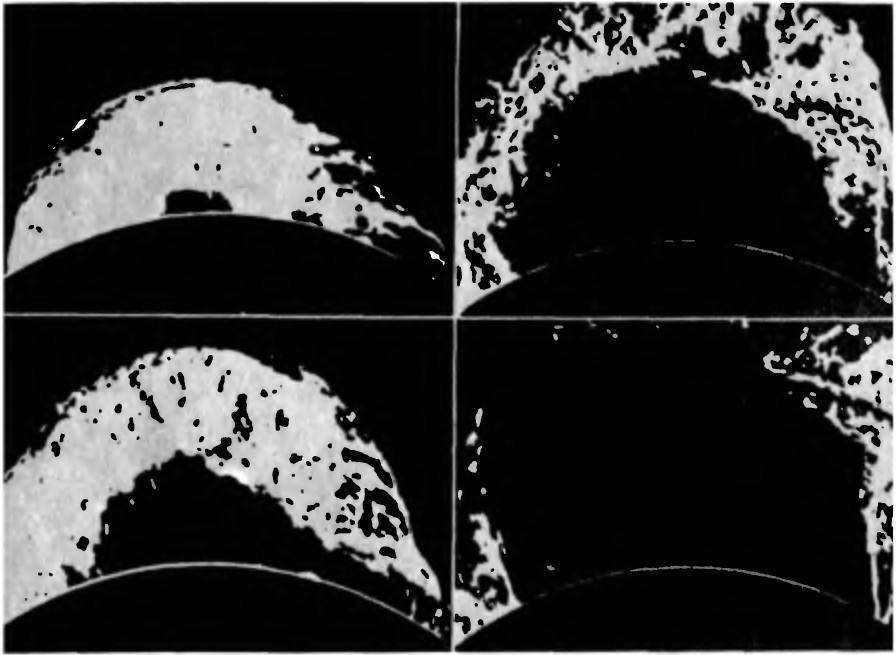
The solar corona maintains a state of dynamic balance, as it constantly receives plasma from the chromosphere and releases a continuous stream of particles (such as protons, helium nuclei, ions, and electrons), known as the solar wind, into interplanetary space. The solar wind particles escape the gravitational pull of the Sun and leave the corona at a velocity of approximately 800 km/s. As the solar wind approaches Earth, its speed decreases to around 500 km/s. The presence of this particle flow from the Sun was initially hypothesized in the mid-19th century to explain the characteristics of comet tails. The Soviet space station Luna-3 conducted the first direct measurements of the composition and velocity of solar wind particles in 1959.

This video tutorial will explore the composition of the solar atmosphere. We will discover which specific layer of the Sun emits the majority of its visible radiation. Additionally, we will become acquainted with distinctive entities and occurrences within the Sun’s atmosphere. Furthermore, we will ascertain the definition of solar activity and gain an understanding of its cyclical nature.
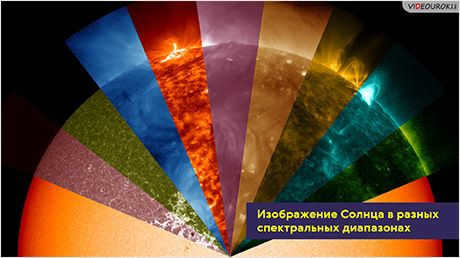
Currently, it is not possible for you to watch or share the instructional video with your students
In order to gain access to this and other video lessons included in the package, you will need to add it to your personal account.
Unlock amazing possibilities


Outline of the Lesson on “The Atmosphere and Activity of the Sun”
The atmosphere of the Sun consists of multiple layers, including the photosphere, the chromosphere, and the corona.
The photosphere is the lowest layer of the Sun’s atmosphere, with a thickness of no more than 300 kilometers.
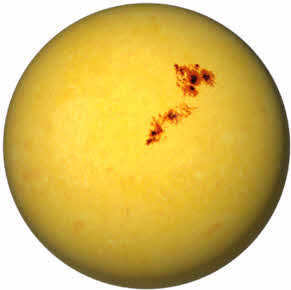
As we move closer to the outer edge of the photosphere, the temperature decreases from 6600 K to 4400 K. At these temperatures, the gas emits most of its energy in the form of light in the optical wavelength range. The photosphere, which appears as a yellowish-bright disk, is the lower layer of the atmosphere that we see as the Sun.
Upon closer examination of the photosphere, we can observe that its surface consists of individual grains called granules. These granules are large plasma bubbles that can have a diameter of 700-1000 kilometers.
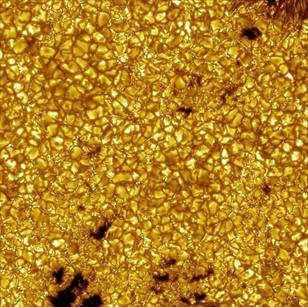
For a brief period of time, typically 5-10 minutes, there exists a single granule. Afterward, a new granule emerges in its place, differing in shape and size from its predecessor. This continuous process of granules appearing and vanishing in the photosphere is referred to as granulation.
The most notable and well-known entities within the Sun’s photosphere are sunspots. Their diameter can reach up to 200,000 kilometers, significantly surpassing that of our planet. Additionally, there are smaller sunspots known as pores.
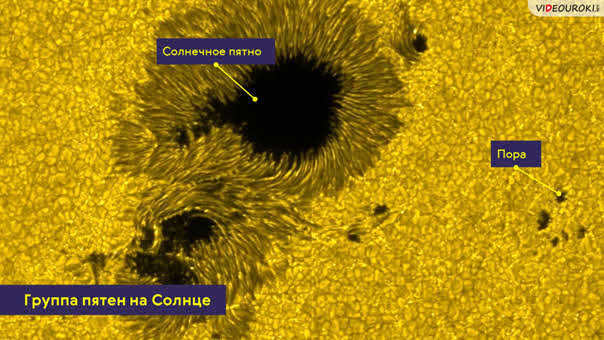
It is worth noting that the first documented observations of sunspots on the Sun can be traced back to the year 800 BC. Interestingly, the earliest recorded depictions of sunspots can be found in John of Worcester’s chronicle from 1128.
Sunspots are specific regions of the Sun that consist of relatively “cooler” gas. In fact, their temperature is approximately 2000-2500 o C lower than that of the surrounding photosphere. As a result, they appear as darker spots in contrast to the overall brightness of the Sun’s surface.
During the early 17th century, the observation of sunspots revealed that their position on the Sun is in constant flux. This led to the discovery that our star rotates on its axis, with its rotation aligning with the motion of the planets. However, the duration of rotation for different parts of the Sun is not uniform. For instance, at the equator, a complete rotation takes approximately 25.05 days, whereas at the poles, the sideric period extends to 34.3 days.
Sunspots are not static entities. Initially, they appear as small, dark regions with a diameter of no more than 3000 kilometers. Many of these spots vanish quickly, but some can grow multiple times in size, merge with other spots to form large clusters, and change their shape and dimensions over the course of several rotations of the Sun.
Despite centuries of observing sunspots, scientists still lack knowledge about their formation mechanism and frequency. On January 17, 2017, European Southern Observatory scientists used the powerful microwave telescope “ALMA” to peer “inside” a sunspot and capture images at a wavelength of 1.25 mm. They anticipate that this breakthrough will eventually lead to uncovering the enigma surrounding these magnetic structures.
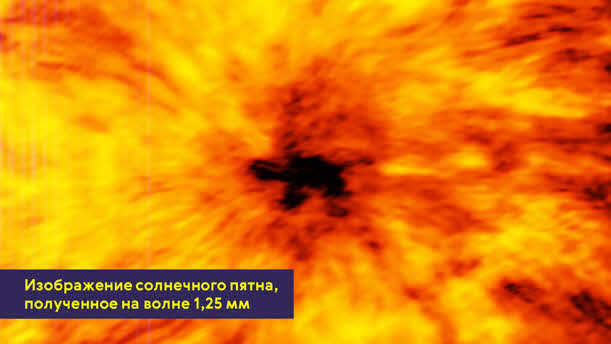
Meanwhile, in the vicinity of the regions where the magnetic field is less strong, there is an increase in convective movements. This is when these vividly hued formations, known as flares, become apparent. The flares possess a complex fibrous structure and have a temperature that surpasses that of the photosphere by several hundred degrees.
During a total solar eclipse, a narrow band of reddish-purple or pink hue can be observed encircling the Moon’s disk. This is the chromosphere of the Sun.
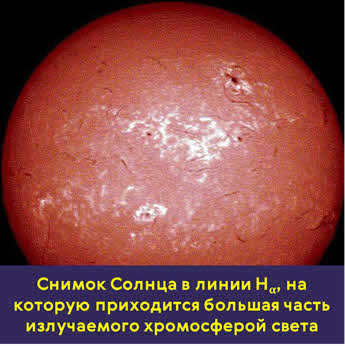
The sun’s atmosphere, known as the chromosphere, is approximately 10,000 kilometers thick. As you go higher in altitude, the temperature of the matter within it increases from 4000 K to 20,000 K. Despite this high temperature, the chromosphere appears dim due to its low matter density.
The chromosphere is primarily composed of spicules, which are slender columns of luminous plasma. These spicules, although small in comparison to the size of the sun, can reach lengths of up to 20,000 kilometers. On average, a spicule has a lifespan of about 5-10 minutes. The Italian astronomer Angelo Secchi, who observed the chromosphere through a telescope in the 19th century, likened it to a blazing prairie.
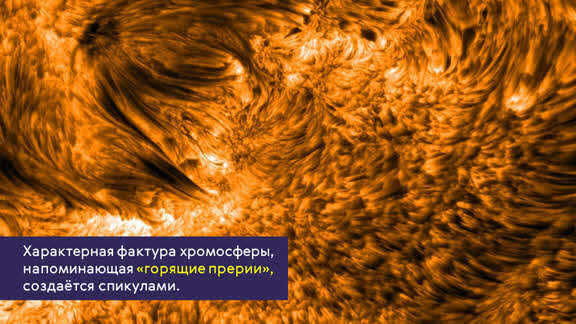
The solar corona, which is several solar radii thick, is the thinnest and hottest part of the Sun’s atmosphere. It is composed primarily of prominences and solar eruptions. These prominences can be observed at the outer edge of the solar disk and appear as enormous arches that rest on the Sun’s chromosphere.
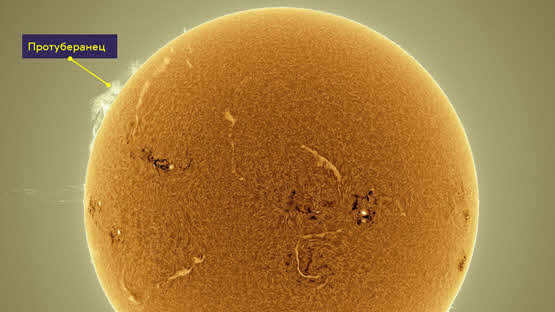
Typically, in the majority of protuberances, matter moves at a slow pace, and their lifespan can extend for several months. However, there are instances when the matter within them starts moving at a considerably faster rate. This is referred to as an active prominence. An active prominence can persist for anywhere from a few tens of minutes to a few days. Afterward, it either dissipates or transforms into an eruptive prominence. These eruptions resemble colossal geysers, occasionally shooting up to 2,000,000 kilometers into the sky. The speed of matter within such formations can reach several hundred kilometers per second.
Extensive research on this phenomenon has revealed that it primarily happens during solar flares. Solar flares are the most potent exhibitions of solar activity, occasionally discharging energy equivalent to the detonation of approximately 160 billion megaton atomic bombs (6 ∙ 10 25 J). To put this in perspective, it is equivalent to the amount of electricity consumed globally over a million years.
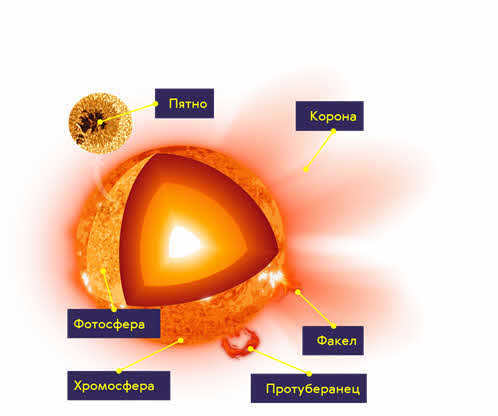
Plasma clouds originating from solar flares and coronal ejections typically reach Earth within a span of two to three days. These clouds trigger geomagnetic storms on our planet, which can have an impact on various technological and biological systems, including humans.
The intensity and frequency of sunspots, prominences, and solar flares exhibit a certain level of periodicity known as solar cyclicity. Although not strictly consistent, these cyclical changes in solar activity are observable and measurable.
One of the most well-known and extensively studied solar cycles is the Schwabe solar cycle, which has an average duration of 11 years (though actual cycle lengths can range from 7.5 to 16 years).
Originating from the outer region of the sun’s corona, the solar wind is a constant and expanding flow of thin plasma. It radiates outwards from the Sun, following magnetic field lines and occupying the vast expanse of interplanetary space.
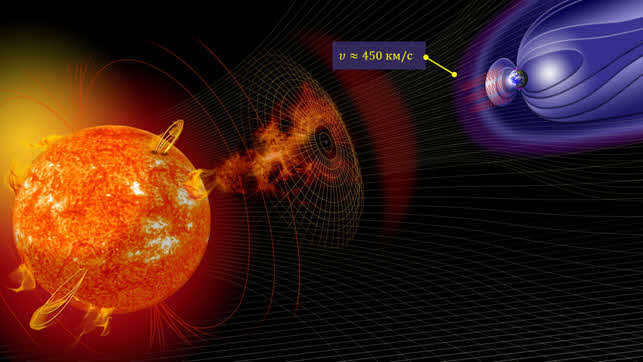
Within close proximity to our planet, the solar wind travels at a speed of approximately 450 km/s, and this speed increases as it moves further away from the Sun. The density of the solar wind near Earth, on the other hand, is quite low, with only a few particles per cubic centimeter.
The flow of solar plasma is unable to overcome the force of the Earth’s magnetic field, causing it to divert around the planet. This results in the formation of a cavity with a drop-like shape, known as the magnetosphere. As we have previously discussed, the magnetosphere has a complex structure. On the side facing the Sun, the boundary of the magnetosphere is compressed due to the pressure exerted by the solar wind. However, on the night side of the Earth, it extends into a long cylindrical tail that stretches a significant distance, with the exact endpoint remaining unknown (although some scientists believe that the length of the Earth’s magnetic tail is approximately 6000 times the radius of the planet).
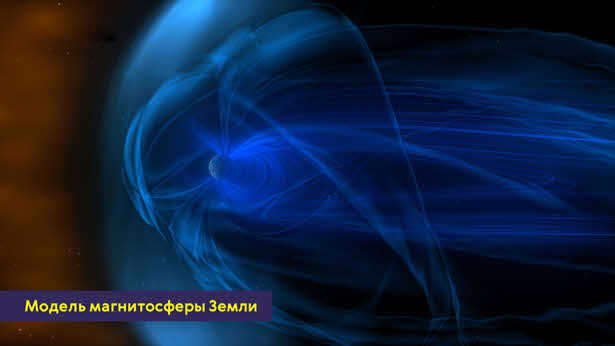
A fraction of the charged particles trapped by Earth’s geomagnetic field create a belt of radiation encircling our planet. Within this belt are protons, ions, and electrons with the highest levels of energy. These particles, originating from the upper atmosphere near the poles, cause the primary constituents of nitrogen and oxygen to emit a glow, resulting in the phenomenon known as the Northern and Southern Lights.
In addition to terrestrial solar telescopes, spacecraft are currently being utilized to actively investigate the Sun. One example is NASA’s launch of two identical STEREO spacecraft into a heliocentric orbit on October 26, 2006. These spacecraft are positioned at different locations within Earth’s orbit, enabling the study of magnetic clouds approaching the Earth from a unique perspective.
On February 1, 2010, the Solar Dynamics Observatory was sent into space. Equipped with advanced technology, it has the ability to capture a diverse range of 12 distinct images of the Sun.
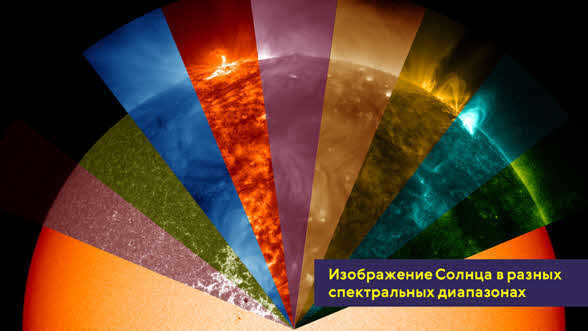
Scientists are able to observe surface details of the Sun with an angular size of 0.6 arc second thanks to the high resolution of the images. Over the course of 2010 to 2015, the space observatory collected a vast amount of data, totaling approximately 2,600 terabytes. Among this data are over 200 million photos of the Sun’s surface.
Here’s an interesting fact: the Sun emits light that appears almost white. However, when the short-wave part of the spectrum is scattered and absorbed by the Earth’s atmosphere, the direct light from the Sun takes on a yellowish hue near the planet’s surface.
Throughout the years, we have acquired a substantial amount of knowledge regarding the functioning of “our” celestial body. Despite the fact that humanity has yet to develop (and is unlikely to ever develop) a scientific spacecraft capable of physically reaching the Sun and gathering samples of its substance, we have already obtained a considerable understanding of its makeup.
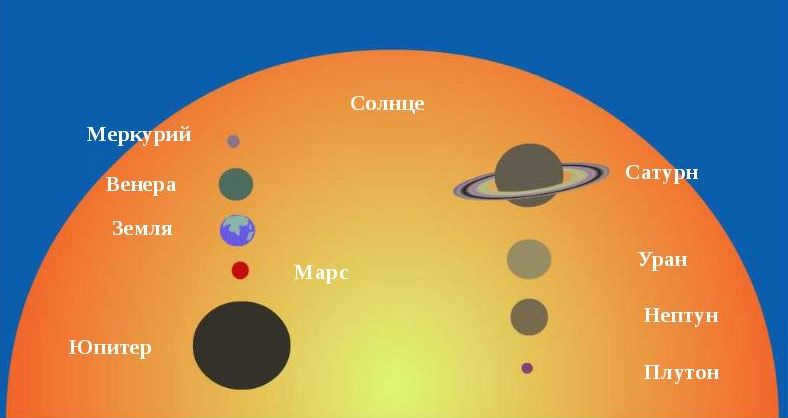

When we compare the size of the Sun with the size of the planets in the solar system, we gain a deeper understanding of our place in the universe.
Thanks to our understanding of physics and the advancements in spectral analysis, we can determine the composition of the Sun. It is composed of approximately 70% hydrogen, 27% helium, and the remaining 2.5% is made up of other elements such as carbon, oxygen, nitrogen, iron, magnesium, and more.
However, our knowledge extends beyond these dry statistics. We have the ability to appreciate the vastness and complexity of the Sun and its relationship to the planets in our solar system.
What Lies Inside the Sun?
Based on modern calculations, the temperature at the core of the Sun reaches an astonishing 15 – 20 million degrees Celsius, while the density of the star’s substance is estimated to be about 1.5 grams per cubic centimeter.
The Sun’s energy stems from an ongoing nuclear reaction that takes place deep beneath its surface, ensuring the sustained high temperature. Hydrogen is converted into helium through nuclear fusion, which generates energy as a byproduct. This fusion process occurs within a region known as the solar core, which spans approximately 150,000 to 175,000 kilometers in radius (about 25% of the Sun’s total radius). The matter density within the solar core is roughly 150 times greater than that of water and nearly 7 times denser than osmium, the densest known substance on Earth.
There are two known types of thermonuclear reactions occurring inside stars: the hydrogen cycle and the carbon cycle. Within the Sun, the hydrogen cycle the hydrogen cycle consists of three stages:
- Hydrogen nuclei transform into deuterium nuclei (an isotope of hydrogen)
- Hydrogen nuclei transform into nuclei of an unstable helium isotope
- The products of the first and second reactions combine to form the stable isotope of helium (Helium-4).
Every second, 4.26 million tons of the star’s matter are converted into radiation. However, when compared to the weight of the Sun, this incredible value is so minuscule that it can be disregarded.
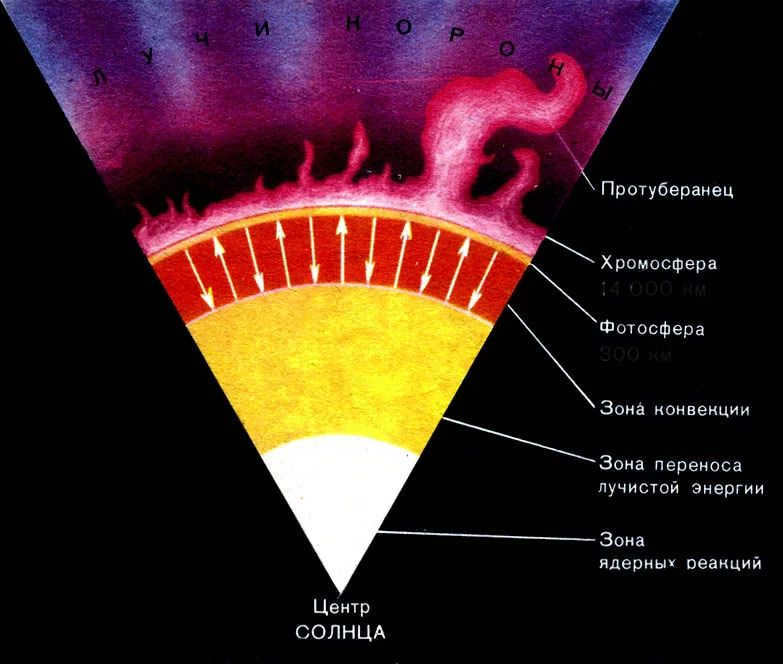
The Sun’s interior is composed of several layers, including the core, convection zone, photosphere, chromosphere, and solar corona.
One of the ways that heat is released from the Sun’s interior is through the absorption of electromagnetic radiation from below and its subsequent re-radiation.
In the convection zone, which is located closer to the surface of the Sun, the energy that is radiated from the interior is primarily transported through the process of convection. This involves the mixing of matter, as warm streams of matter rise towards the surface while cold streams descend. The convection zone extends to a depth of approximately 10% of the solar diameter and nearly reaches the surface of the star.
The Atmosphere of the Sun
The Sun does not have a solid surface. The density of the Sun’s corona is 100,000,000,000,000,000 times lower than the density of air, and the material of the corona gradually dissipates into space. A layer that is 10 times closer to the Sun’s center than the upper regions of the corona is considered to be the Sun’s surface. This is where the convection zone ends.
Beyond the convection zone, the atmosphere of the Sun begins, where energy transfer once again occurs through radiation.
The photosphere is the visible surface of the Sun and the lower layer of the solar atmosphere. It has a thickness of approximately 100-400 km and accounts for about 2/3 of the Sun’s optical thickness. The photosphere is responsible for emitting the Sun’s visible radiation, with temperatures ranging from 6600 K to 4400 K at the upper edge.
Due to a rapid decrease in brightness at the edge of the photosphere, the Sun appears as a perfect circle with distinct boundaries. The brightness at the edges is only 20% of the brightness at the center of the Sun’s disk.
The chromosphere is the Sun’s second atmospheric layer, enveloping the photosphere and spanning approximately 2000 km in thickness. As we ascend through the chromosphere, temperatures rise from 4000 K to 20,000 K. Due to its relatively low density, the chromosphere eludes visibility when observing the Sun from Earth. However, during solar eclipses, a vibrant crimson aura manifests along the periphery of the solar disk, revealing the presence of the star’s chromosphere.

The magnificent display of the solar corona can only be witnessed during the rare occurrence of a solar eclipse.
Solar wind
The phenomenon known as the solar wind involves the release of charged particles (including protons and electrons) from the heated outer layers of a star’s atmosphere, extending all the way to the boundaries of our planetary system. This continuous emission causes the star to shed millions of tons of mass every second.
In the vicinity of Earth’s orbit, solar wind particles travel at an astonishing speed of 400 kilometers per second, traversing our stellar system at supersonic velocities. The density of the solar wind ranges from a few to several dozen ionized particles per cubic centimeter.
The solar wind mercilessly interacts with the atmosphere of the planets, causing the gases within to be expelled into outer space. This phenomenon is also responsible for the formation of comets’ tails. Fortunately, the planet’s magnetic field acts as an invisible shield against the solar wind, preventing the escape of atmospheric atoms into space and allowing the Earth to withstand its effects. When the solar wind collides with the planet’s magnetic field, it creates a dazzling optical display known as the aurora borealis, often accompanied by magnetic storms.
Nevertheless, the solar wind also serves a vital purpose by sweeping away galactic radiation from the solar system, protecting our stellar system from external cosmic radiation.
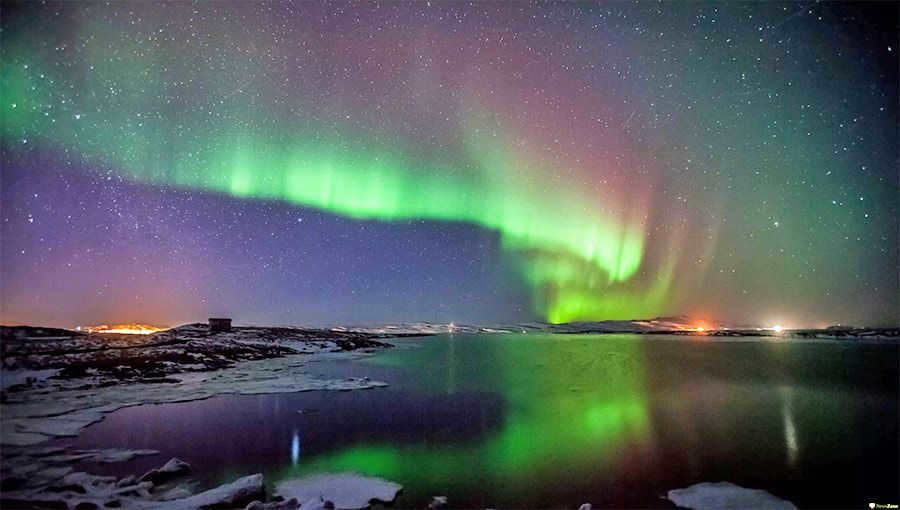

When marveling at the mesmerizing spectacle of the northern lights, it is difficult to fathom that these captivating bursts of light serve as a tangible indication of the solar wind and the Earth’s magnetosphere
The investigation into the impact of solar wind streams on Earth, as well as the characteristics of the wind itself, has been ongoing for over five decades since Eugene Parker, an American scientist, first theorized and named these previously unknown streams of solar matter as solar wind. The solar wind is comprised of electrons, protons, helium nuclei, and heavier elements. It is associated with a magnetic field of intricate configuration, resulting from the Sun’s rotation and the movement of plasma streams away from it. The solar wind permeates the entire interplanetary space, interacting with the magnetospheres of various planets and extending a hundred times beyond the orbit of Earth.
Researchers employ various scientific methods to study the solar wind, yet the reason behind its acceleration to supersonic velocities over the surface of the Sun remains elusive.
Y. Parker postulated that the reduction in gravitational force as altitude increases in the corona leads to the acceleration of matter being expelled from the corona. However, these explanations are deemed inadequate as there must exist another mechanism for plasma acceleration.
Multiple space observatories, numbering at least ten, are engaged in the investigation of the Sun, amassing an immense volume of observational data. Nevertheless, the causes behind the corona’s elevated temperature and the acceleration of the solar wind continue to elude scientists.
Magnetic Clouds: A Unique Phenomenon in Interplanetary Space
Magnetic clouds, which emerge in interplanetary space following prominences and solar flares, are distinct regions of the solar wind characterized by an intensified magnetic field. These magnetic clouds result from coronal mass ejections that transport a frozen magnetic field, carrying the same strength as its source, into the vast expanse of interplanetary space. As these magnetic clouds reach Earth, they trigger magnetic storms and disruptions within the magnetosphere.
Scientists rely on spacecraft equipped with advanced instruments capable of directly measuring the solar wind’s properties, such as the magnitude and direction of the magnetic field, to identify and study magnetic clouds. By investigating these unique phenomena, researchers aim to gain insights into the early prediction of magnetic storms, a critical endeavor in space weather forecasting.
The Earth’s atmosphere is the gas envelope that surrounds our planet and provides us with the air we breathe. Similar gas shells can also be found on other planets. Stars, on the other hand, are made entirely of gas and their outer layers are also referred to as atmospheres. These outer layers are where some of the radiation can escape into space without being absorbed by the layers above.
Photosphere – the Sun’s atmosphere
Photosphere – The atmosphere of the Sun starts about 200-300 km below the visible boundary of the solar surface. These innermost layers of the atmosphere are known as the photosphere. Due to their thinness, which is less than one three-thousandth of the radius of the Sun, the photosphere is often referred to as the Sun’s surface.
The photosphere, which is the Sun’s coolest layer with temperatures ranging from 6000 to 4400 K, functions as a absorber and emitter of all the radiation emitted by the core.
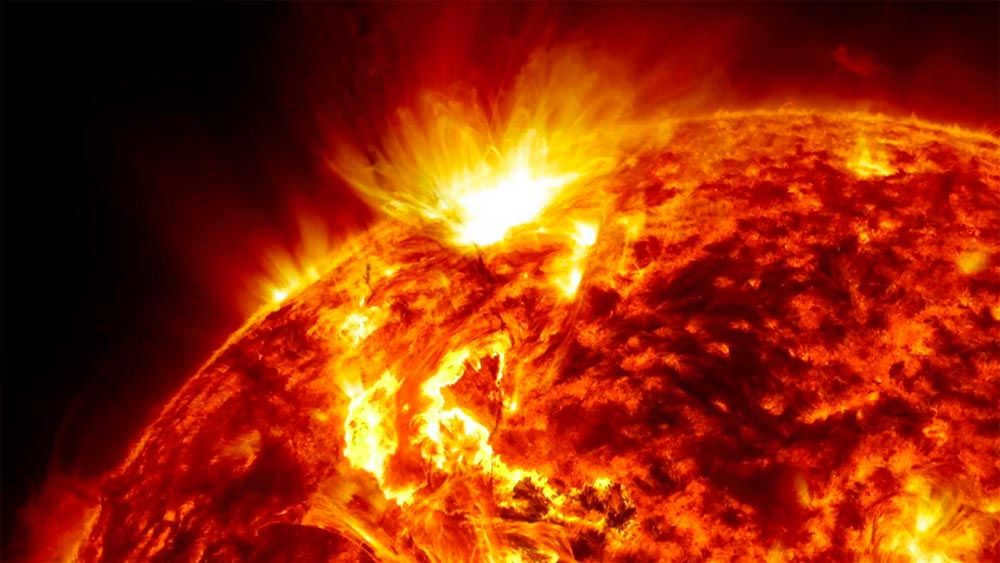

The photosphere is composed of a layer in the Sun’s atmosphere. This is the layer that we observe from Earth.
The density of gases in the photosphere is similar to that of the Earth’s stratosphere, but much lower than at the Earth’s surface. The temperature of the photosphere decreases from 6000 K at a depth of 300 km to 4000 K in the upper layers.
When observing the solar surface through a telescope in the visible wavelength range, it appears as a collection of bright regions surrounded by narrow dark gaps. These bright regions are known as solar granules, and they vary in size, averaging about 700 km. Each granule has a lifespan of approximately 8 minutes before appearing and disappearing. The granules are separated by dark gaps that are about 300 km wide.
The temperature of the middle layer, which is the layer we observe radiation from, is approximately 6000 K. In these conditions, the majority of gas molecules separate into individual atoms. Only in the uppermost layers of the photosphere, a small number of simple molecules and radicals such as H2, OH, CH remain.
An important component of the solar atmosphere is the negative hydrogen ion, which consists of a proton and two electrons and is not found in nature on Earth. This unique compound forms in the outermost and coolest layer of the photosphere when negatively charged free electrons attach to neutral hydrogen atoms. These hydrogen atoms are provided by easily ionizable elements such as calcium, sodium, magnesium, iron, and other metals.
When negative hydrogen ions emerge, they emit a significant amount of visible light. These ions also absorb this light greedily, leading to a rapid increase in atmospheric opacity with depth. As a result, the visible edge of the Sun appears exceptionally sharp to the observer.
The majority of our understanding of the Sun is derived from analyzing its spectrum, which resembles a narrow, multicolored strip similar to a rainbow. Sir Isaac Newton first obtained this strip by placing a prism in the path of sunlight and exclaimed, “Spectrum!” Subsequently, researchers noticed dark lines within the Sun’s spectrum, which were originally believed to be boundaries between colors.
The temperature discrepancy between the outer layers of the Sun is relatively minor (200-300 K), but it becomes more significant in the convective zone, where mixing is highly active. Convection within the Sun’s outer layers greatly influences the overall structure of its atmosphere. Ultimately, it is the intricate interplay between convection and solar magnetic fields that gives rise to the wide range of solar activity. Magnetic fields are integral to all Sun-related processes.
Sometimes, in a small area of the solar atmosphere, there are concentrated magnetic fields that are several thousand times more intense than those on Earth. Ionized plasma, being a good conductor, is unable to move across the magnetic field lines of a strong magnetic field. As a result, the mixing and upward movement of hot gases from below is hindered in these areas, leading to the formation of a dark region called a sunspot. Against the backdrop of the bright photosphere, the sunspot appears completely black, although its actual brightness is only ten times dimmer.
Over time, the spots undergo significant changes in their size and shape. Initially, they appear as tiny pores that are barely noticeable, but then they gradually expand to reach sizes of several tens of thousands of kilometers. Typically, these larger spots consist of a dark core and a relatively lighter penumbra, which gives them a vortex-like appearance. Additionally, the spots are encompassed by brighter regions of the photosphere known as flares or flare fields.
The transition from the photosphere to the thinner outer layers of the solar atmosphere, namely the chromosphere and solar corona, occurs gradually.
The Sun’s chromosphere, which derives its name from the Greek word meaning “sphere of color,” displays a distinct reddish-purple hue. During a total solar eclipse, it becomes visible as a radiant and ethereal ring encircling the Moon, which has momentarily obscured the Sun. Composed of a diverse array of elements, the chromosphere is predominantly characterized by elongated structures known as spicules, resembling flickering blades of grass.
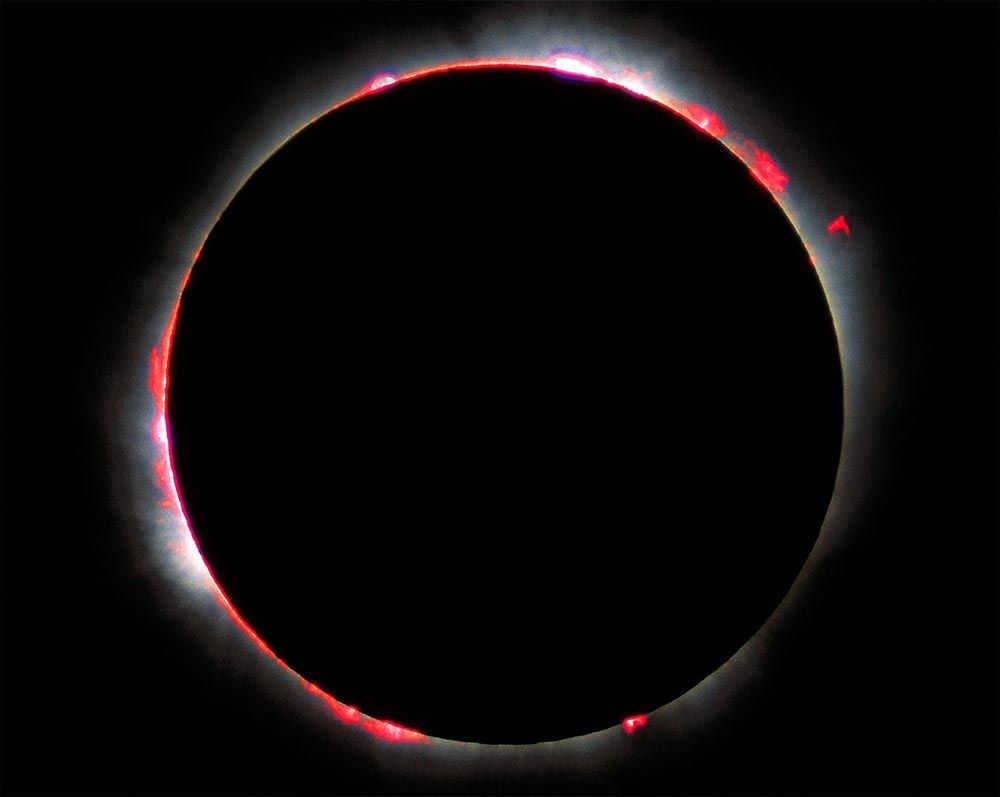

When a total solar eclipse occurs and the Sun’s visible surface is obscured, we are able to observe the chromosphere, which is a narrow, luminous ring that encircles the outer edge of the solar disk.
The temperature of these chromospheric jets can reach two to three times higher than that of the photosphere, while the density is hundreds of thousands of times lower. The entire length of the chromosphere spans approximately 10-15 thousand kilometers.
The increase in temperature in the chromosphere is attributed to the transmission of waves and magnetic fields from the convective zone. The heating of matter can be likened to the process that occurs in a massive microwave oven. As a result, the thermal velocities of particles rise, leading to more frequent collisions and the loss of outer electrons in atoms, ultimately transforming the matter into a hot ionized plasma. These same physical processes are also responsible for the abnormally high temperatures observed in the outer layers of the solar atmosphere that lie above the chromosphere.
The most frequent are “silent” prominences, which typically occur in conjunction with the formation of a cluster of sunspots, although they persist for much longer periods than sunspots (up to 1 year). Directly within the sunspot region, following flares, prominences of sunspots can be observed – streams of gas that flow from the corona into the sunspot region at speeds of several tens of kilometers per second. Another variety of prominence is linked to the upward expulsion of matter (typically following flares) at velocities ranging from 100 to 1000 km/s (rapid eruptive prominences).
When hydrogen atoms emit light in the red spectral line, they create dark, long, and curved fibers that can be seen against the backdrop of the solar disk.
Prominences have a similar density and temperature to the chromosphere, but they exist above it and are surrounded by the highly rarefied upper layers of the solar atmosphere. The reason prominences do not fall into the chromosphere is because their matter is supported by the Sun’s magnetic fields in active regions.
In 1868, French astronomer Pierre Janssen and his English colleague Joseph Lockyer were the first to observe the spectrum of a prominence outside of an eclipse. They positioned the spectroscope’s slit in a way that it crossed the edge of the Sun, allowing them to observe the spectrum of radiation emitted by any nearby prominences.
By directing the slit towards different regions of the prominence or chromosphere, it becomes feasible to examine them in a segmented manner. The spectrum of prominences, akin to the chromosphere, is comprised of vivid lines, primarily consisting of hydrogen, helium, and calcium. There are also fainter spectral lines attributed to other chemical elements.
Occasionally, certain prominences, which have remained unchanged for a considerable period, undergo sudden eruptions, expelling their material into the expanse of interplanetary space at velocities reaching hundreds of kilometers per second. The appearance of the chromosphere also experiences frequent alterations, indicative of the perpetual movement of its constituent gases.
Occasionally, there are instances of explosive events in small areas of the Sun’s atmosphere. These events are known as chromospheric flares, which are the most intense explosion-like phenomena. They typically last for a few minutes, but during this time, a significant amount of energy, sometimes up to 1025 J, is released.
These flares usually persist for several tens of minutes. When they occur, the luminosity of a specific section of the chromosphere suddenly increases by a factor of ten in hydrogen, helium, ionized calcium, and other element spectral lines. The increase in ultraviolet and X-ray radiation is particularly significant, with the power sometimes exceeding the total power of the Sun’s radiation in the short-wave region of the spectrum before the flare.
Spots, flares, prominences, and chromospheric flares are all indications of solar activity. As solar activity intensifies, the number of these phenomena on the Sun increases.
The Sun’s Corona
The corona, which is the outermost layer of the Sun’s atmosphere, is significantly larger in size compared to the photosphere and chromosphere. It extends for millions of kilometers, equivalent to several solar radii, and its faint extension reaches even further.
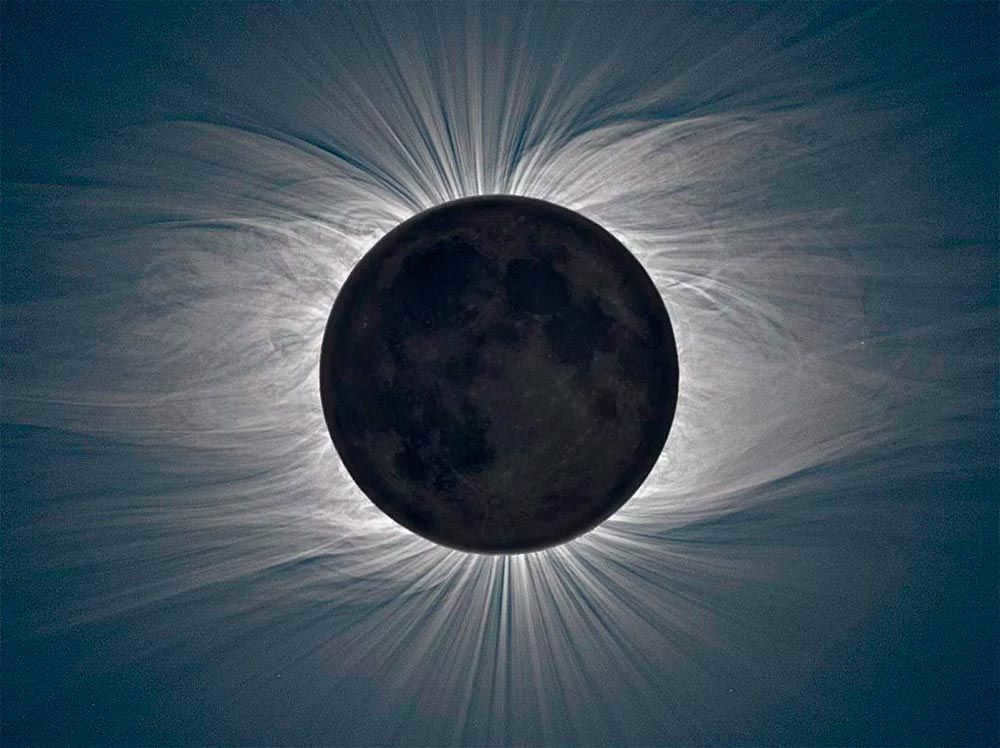
The solar corona, captured once again during a total solar eclipse
The density of matter in the sun’s corona decreases at a much slower rate with increasing height compared to the density of air in Earth’s atmosphere. The decrease in air density as you move higher up is primarily influenced by Earth’s gravity. However, at the surface of the Sun, gravity is significantly stronger, suggesting that its atmosphere should not extend very far.
Surprisingly, the solar corona is unusually expansive. This can be attributed to the presence of certain forces that counteract the Sun’s gravity. These forces are associated with the immense velocities of atoms and electrons in the corona, which are heated to temperatures ranging from 1-2 million degrees Celsius!
The best time to observe the corona is during a total solar eclipse. However, it is extremely challenging to accurately depict the corona’s individual features or its overall appearance during the short duration of the eclipse. As the observer’s eyes adjust to the sudden darkness, the appearance of the bright sunlight peering out from behind the moon signals the end of the eclipse. Consequently, sketches of the corona created by experienced observers during the same eclipse often varied significantly. Even determining the corona’s true color was a difficult task.
The discovery of photography provided astronomers with a reliable and recorded approach to research. Nevertheless, capturing a clear image of the corona is no easy task. The inner corona, the portion closest to the Sun, is relatively bright, while the outer corona, which extends much further, appears as a faint glow. Consequently, when the outer corona is visible in photographs, the inner corona is overexposed, and when the details of the inner corona are visible, the outer corona becomes completely invisible in the photographs.
To overcome this challenge, people often attempt to capture multiple images of the corona during an eclipse using slow shutter speeds. Another technique involves using a specialized “radial” filter to reduce the brightness of the inner regions of the corona. These photographs can reveal the structure of the corona up to several solar radii away.
The initial successful photographs have already unveiled numerous intricate features in the corona, such as coronal rays, various arcs, helmets, and other complex formations that are clearly connected to active regions.
During the 11-year cycle, there are changes in both the overall brightness and the form of the solar corona.
During the period of maximum sunspot activity, the corona takes on a more rounded shape. The rays of the corona are observed in a direct and radial manner along the Sun’s radius, both at the equator and in the polar regions. However, when there are fewer sunspots, the coronal rays only form at the equatorial and mid-latitudes, causing the corona to become elongated in shape. Additionally, distinct short rays known as polar brushes appear near the poles. Coinciding with these changes, the overall brightness of the corona decreases.
This intriguing characteristic of the corona appears to be linked to the progressive shift of the region where spots are most commonly formed during the 11-year cycle. Following the minimum, spots start to emerge on both sides of the equator at latitudes 30-40°. Subsequently, the spot formation zone gradually descends towards the equator.
Thorough investigations have confirmed the existence of a definite correlation between the structure of the corona and specific phenomena in the Sun’s atmosphere. For instance, bright and straight coronal rays are typically observed above spots and flares, with neighboring rays curving towards them. Moreover, the brightness of the chromosphere increases at the base of the coronal rays.
The region of the chromosphere known as the excited region is commonly referred to as such due to its higher temperature and density compared to neighboring unexcited regions. In the corona, bright and intricate formations can be observed above spots. Prominences are frequently surrounded by envelopes of coronal matter.
The corona serves as a unique natural laboratory where matter can be studied under extraordinary and unattainable conditions found on Earth.
During the late 19th and early 20th centuries, when plasma physics was still in its infancy, the features of the corona were a baffling mystery. Remarkably, the corona appears to have a similar color to the Sun, almost as if its light is reflected by a mirror. However, in the inner corona, the characteristic Fraunhofer lines of the solar spectrum vanish completely. They only reappear in the outer corona, far away from the Sun’s edge, but are significantly weaker.
Moreover, the corona’s light is polarized: the majority of the light waves oscillate in planes that are mostly tangential to the solar disk. As one moves away from the Sun, the amount of polarized light initially rises (reaching nearly 50%) and then diminishes. Eventually, distinct emission lines become visible in the corona’s spectrum, which, up until the mid-20th century, remained unattributed to any known chemical elements.
The impact of electrons is so powerful that light elements lose almost all their electrons, leaving only the atomic nuclei. On the other hand, heavier elements retain some of their electron shells, resulting in a high degree of ionization.
Consequently, coronal gas is a plasma with a high level of ionization. It consists of numerous positively charged ions from various chemical elements and a slightly larger number of free electrons. These electrons are produced through the ionization of hydrogen atoms (one electron each), helium (two electrons each), and heavier atoms.
Since the movement of electrons is crucial in this type of gas, it is often referred to as an electron gas. However, this term assumes the presence of enough positive ions to maintain the overall neutrality of the plasma.
The corona appears white because the free electrons scatter ordinary sunlight, causing it to change direction and become polarized. These electrons do not add any energy to the scattering process, only altering the path of the light waves. Additionally, the spectrum of the corona contains bright lines that are the result of unique emission from highly ionized atoms such as iron, argon, nickel, calcium, and other elements. These emissions are only observed under specific conditions of strong rarefaction.
Ultimately, the presence of absorption lines in the outer corona can be attributed to the scattering phenomenon on dust particles that are consistently present within the interstellar medium. Conversely, the lack of lines in the inner corona can be attributed to the fact that when light quanta undergo scattering with highly accelerated electrons, their frequencies experience such substantial alterations that even the prominent Fraunhofer lines within the solar spectrum become completely “erased”.
Hence, the corona of the Sun represents the utmost layer of its atmosphere, characterized by its rarified and scorching nature. Additionally, it is worth mentioning that it is also the nearest to us: it extends far away from the Sun in the form of continuously moving streams of plasma known as the solar wind. In proximity to Earth, its average velocity reaches 400-500 km/s, occasionally even approaching 1000 km/s.





